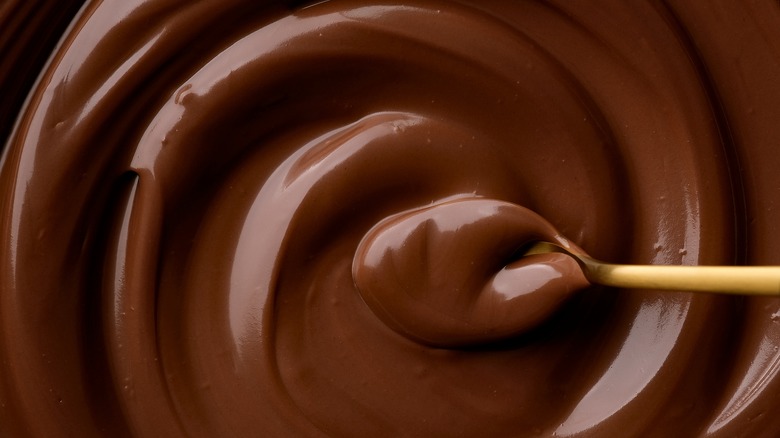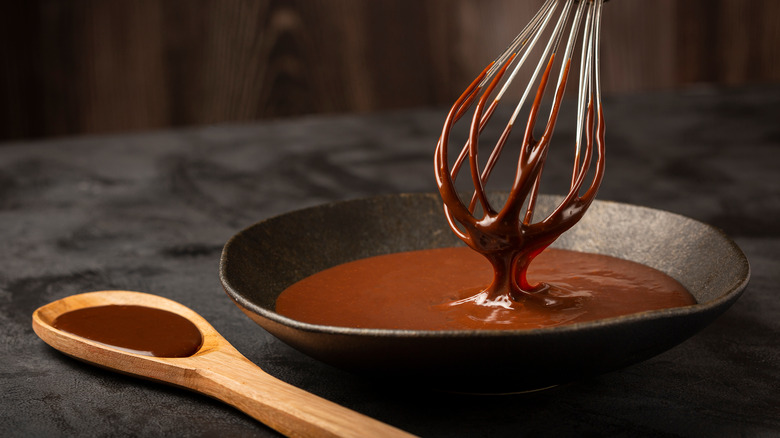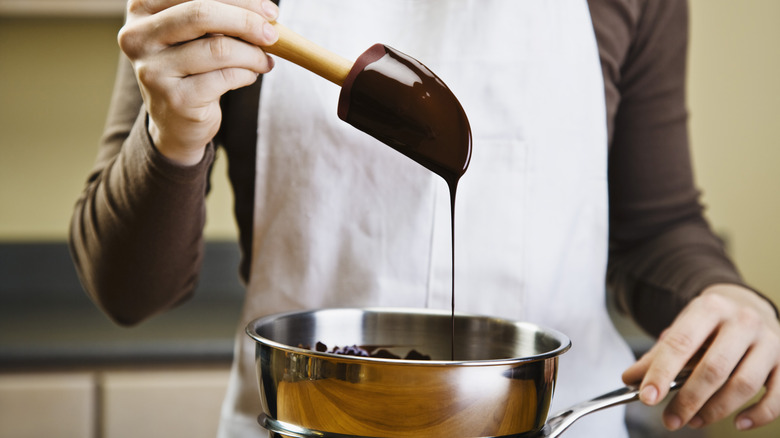The Best Way To Salvage Seized Chocolate
If you ever find yourself stirring a quickly solidifying mass of chocolate that looks nothing like the glossy ribbons of liquid cocoa you'd envisioned when you set about making some sweet treat, don't panic. The mixture can seize up for a few reasons, and the main culprit is generally water. Even a little moisture on your utensils is enough to clump up chocolate by making the cocoa and sugar particles stick together. Sometimes, clumping can also be a result of overheating chocolate.
Seized chocolate quickly turns brittle, making it challenging to work with. Interestingly, the most common way to fix it is to look to the culprit. Adding a small amount of hot water can help loosen the chocolate, as can a little bit of vegetable shortening or other suitable fat. Depending on how urgently you need the chocolate, you can also put it away and use it for an alternate sweet treat — anything from brownies to chocolate ganache. The point is that chocolate is too delicious to give up on, and there's almost always a way it can be recovered.
Fighting water with water and other methods to fix seized chocolate
You'll know pretty quickly when your chocolate starts seizing up. One minute, you're stirring; and the next your spatula faces resistance. If you're heating chocolate, take it off the heat immediately and put some water to boil instead. It may seem strange, but putting in hot water one teaspoon at a time while stirring vigorously can help make your chocolate smooth again.
If that doesn't work, more drastic measures are needed, and you must add fat. Vegetable shortening, butter, and coconut oil all work — about one tablespoon for every 6 ounces of chocolate used. One crucial factor when choosing a salvaging method is what you plan on doing with the chocolate. Mixing in hot water will dilute it somewhat, but it's still suitable to be drizzled or used as a sauce. If, however, it's intended for a bake or no-bake dessert of some kind, you're better off using fat.
Suppose you've got some flexibility with using up seized chocolate; a few more delicious options open up. Sure, you can add it to another batch of brownie batter and enjoy chunkier, more chocolatey brownies. Or, mix cream into seized chocolate and stir it up to make ganache. Whichever method you use, some vigorous stirring will be required. If you want to avoid the elbow grease, spread the chocolate on parchment paper and let it dry in the fridge overnight until it's ready to melt again.
Tips to avoid seizing your chocolate
The reason water is so dangerous for melted chocolate is that it combines with the sugar in chocolate to form a sticky syrup, which then clumps up the cocoa solids. Therefore, the best way to avoid seizing chocolate is to ensure it doesn't come into contact with water when melting it. Make sure all your utensils are dry and nonporous because wood, for example, can transmit absorbed moisture into your melted chocolate. Also, covering hot melted chocolate will result in condensation raining down from the lid into the mixture, so watch out for that as well.
Another common reason chocolate seizes up is if it is overheated. Different types of chocolate have different threshold temperatures. Dark chocolate can take up to about 120 degrees Fahrenheit, while white and milk chocolates will seize up at even lower temperatures. Therefore, even while using a double boiler, it's a good idea to use a food thermometer to ensure safe temperatures. The chances of overheating go up drastically if you're melting chocolate in the microwave, so if you like to live that dangerously, do so in small bursts. If you find the chocolate's temperature reaching its limit, the quickest way to bring it down is to add a little more chocolate. But then, isn't "add more chocolate" the answer to everything?


